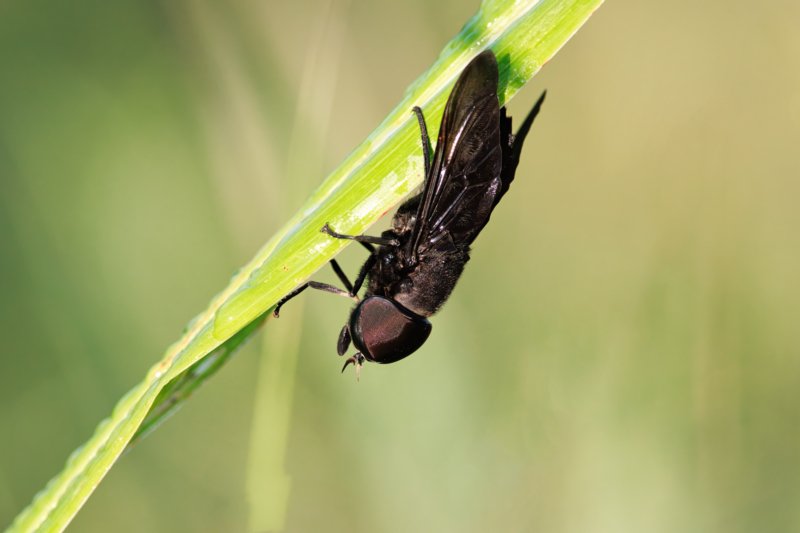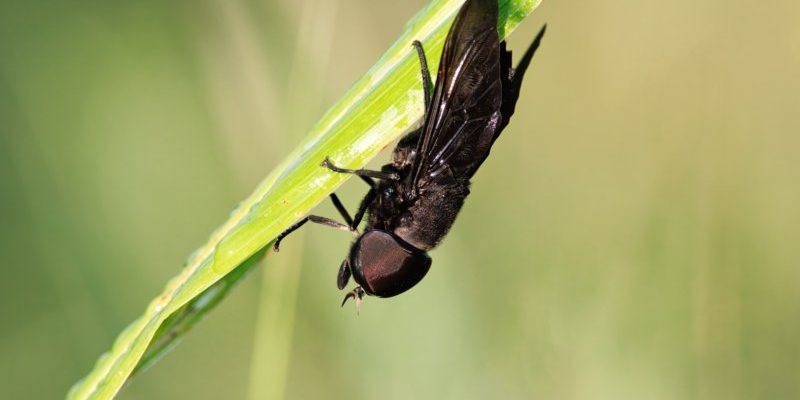
What is a Horsefly?
Horseflies are large, biting flies that belong to the Tabanidae family. You might recognize them by their prominent eyes and robust bodies. Unlike houseflies, horseflies have a much more intimidating presence. They are known for their painful bites, which can be quite annoying to both humans and animals alike. Imagine being outside on a warm, sunny day, and suddenly, you feel a sharp sting on your skin—chances are, it’s a horsefly!
These insects typically thrive in warm environments and are commonly found near water sources, such as rivers and ponds. Horseflies are not just nuisances; they play a role in the ecosystem as well. They are attracted to the heat of animals, including livestock, which makes them a common sight on farms. It’s almost like they have a radar for their next meal.
In this article, we’ll dive deeper into the fascinating world of horseflies, including their behaviors, habitats, and the impact they have on both humans and animals.
Appearance and Size
Horseflies are often mistaken for other types of flies due to their size and color patterns. Typically, they measure between 1⁄2 inch to just over an inch in length. Their bodies can be dull brown, gray, or black, often with patterned markings. What really sets them apart, though, are their highly distinctive large, compound eyes. In fact, some species have eyes that can take up a significant portion of their head, allowing them to see in nearly all directions.
At first glance, a horsefly might seem fearsome, and that’s no accident! Their robust bodies and fast flying speed—often clocked at about 15 miles per hour—allow them to evade predators. When they zoom around, you might think they are just a pest, but they’re quite the agile fliers. This speed, combined with their ability to bite, makes them a challenge to swat away!
Most horseflies are also equipped with sharp mouthparts that enable them to pierce skin easily. As they bite into their target, they can draw blood, which is crucial for their reproductive process. Female horseflies need blood to acquire the necessary proteins for their eggs. So, the next time you feel that sharp sting, remember it’s not just a random attack; it’s a part of their life cycle.
Habitat and Distribution
Horseflies thrive in various environments, but they tend to prefer warm, moist areas. You’ll often find them near lakes, ponds, marshes, and even in grassy fields. They are typically seen during the summer months when the weather is warm—making sunny days their playground. If you’re planning a picnic near a body of water, be mindful that these buzzing insects may be lurking nearby.
In terms of global distribution, horseflies can be found almost everywhere except in extremely cold regions. In the United States, they are most commonly spotted in agricultural areas where livestock are present since their primary food source is usually warm-blooded animals. Regions with higher humidity levels typically have a higher concentration of horseflies, so if you live in one of those areas, consider yourself on their radar.
They are also highly mobile insects, able to travel long distances to find food and suitable habitats. This means that if you’ve encountered horseflies in one place, they can easily pop up elsewhere. Being aware of their behaviors can help you anticipate where to find them and how to defend yourself if you’re planning to spend time outdoors.
Diet and Feeding Habits
When it comes to their diet, horseflies are mainly blood-feeders. Female horseflies are the ones that require blood for their reproductive process. They possess specialized mouthparts adapted for cutting through the skin of their hosts. This is why their bites can be particularly painful. Menacing as they may seem, male horseflies feed primarily on nectar and plant juices. They prefer a plant-based diet, which is a big contrast to the females.
The way horseflies feed is quite interesting. Using their sharp mouthparts, they slice through tissue to access blood, and they often remain attached for several minutes while they consume. Surprisingly, they secrete saliva that acts as an anticoagulant, preventing the blood from clotting while they feed. This means that their bite not only hurts but also causes irritation and can lead to infection if not addressed.
If you keep livestock, it’s essential to be aware of the dangers they pose. Not only can horseflies cause discomfort to animals, but they can also transmit diseases. For instance, in cattle, they can spread diseases like anaplasmosis and summer mastitis. Monitoring horsefly populations during peak seasons is crucial to safeguard your animals’ health.
Life Cycle of the Horsefly
The life cycle of a horsefly is quite intriguing, and it goes through four distinct stages: egg, larva, pupa, and adult. Female horseflies lay their eggs in batches, usually on vegetation near water sources. The eggs are small and are often laid in clusters, making them easy to spot if you happen to be looking out for them.
Once the eggs hatch, the larvae emerge, seeking out moist soil or water where they can thrive. Horsefly larvae are predatory and feed on smaller insects, which can help regulate those populations. This predatory nature is fascinating since it contrasts with the adult’s need for blood. As they grow, larvae develop into pupae, where they begin their transformation into adult horseflies.
After a period spent in the pupal stage, adult horseflies emerge, ready to start the cycle all over again. They usually live for several weeks to a few months, depending on environmental conditions and availability of food. This lifecycle shows a remarkable adaptability that allows horseflies to thrive in various conditions.
Impact on Humans and Animals
Horseflies can have a significant impact on both humans and animals, especially in rural or farming areas. For people, their bites can be quite painful and irritating. Some individuals may even experience allergic reactions that require medical attention. If you’ve ever experienced a horsefly bite, you know how they can ruin a lovely day outdoors.
For animals, especially livestock, horseflies can be even more problematic. They can lead to stress and discomfort, which may reduce productivity in animals like cows and horses. Additionally, horses are particularly sensitive to bites, which makes outdoor activities such as riding or farming more difficult.
In some regions, horseflies are also known carriers of diseases, and their presence can pose serious threats to livestock health. This can result in significant economic losses for farmers due to reduced milk production or the need for veterinary care. Managing horsefly populations in farm settings is essential to ensure the well-being of both the animals and the people who care for them.
Control and Prevention Methods
Preventing horsefly bites requires a combination of awareness and proactive measures. One effective way to keep these pests at bay is by wearing protective clothing. If you know you’ll be spending time outdoors in horsefly-prone areas, wear long sleeves and pants to shield your skin from bites. Additionally, light-colored clothing is less likely to attract these insects compared to dark hues.
Using insect repellents that contain DEET or Picaridin can also be effective in discouraging horseflies from getting too close. Make sure to reapply the repellent as directed, especially if you’re sweating or spending long periods outdoors.
If you’re a farmer, consider using traps that target horseflies. These traps can help reduce their populations around cattle and horses. Regularly checking the areas where livestock are kept and removing any standing water can also minimize breeding grounds for horseflies. By understanding their behavior and taking precautionary steps, you can help create a more horsefly-free environment.
Horseflies may be a nuisance, but they play an intriguing role in the ecosystem. Understanding their life cycles, diets, and the impact they have on both humans and animals can help us navigate our environments better. Whether you’re out for a leisurely walk by the water or managing livestock on a farm, being aware of these buzzing insects will keep you one step ahead. The next time you feel a sting, you’ll know exactly what’s buzzing around you!
FAQ
What are the signs of a horsefly bite?
If you’ve been bitten by a horsefly, you’ll likely notice a painful, raised red bump at the site. The bite may itch and swell, and sometimes it can become inflamed. In more severe cases, individuals might experience allergic reactions like hives or extreme itching. If you notice any unusual symptoms, it’s best to consult a medical professional.
Are horseflies dangerous to humans?
Generally, horseflies are not dangerous to humans in terms of spreading diseases, unlike their relatives, mosquitoes. However, their bites can be quite painful and may lead to secondary infections if not treated properly. It’s important to clean the bite area thoroughly and monitor for any signs of infection.
How can I prevent horseflies from biting me?
To prevent horsefly bites, wear protective clothing, especially light-colored long-sleeved shirts and pants. Applying insect repellent that contains DEET can also help keep them at bay. Staying away from water sources where horseflies breed will also reduce your chances of encountering them.
Do all horseflies bite?
Not all horseflies bite, but female horseflies are the ones that require blood to lay their eggs. Males, on the other hand, primarily feed on nectar and do not bite. So, while you may notice a buzzing sound from both genders, only the females will be the ones to cause discomfort.
What is the lifespan of a horsefly?
Adult horseflies typically live for a few weeks to a few months. Their lifespan can vary based on environmental conditions and the availability of food sources. The whole life cycle, including the egg, larva, and pupal stages, adds several weeks or months to their overall life duration.
Can horseflies transmit diseases to animals?
Yes, horseflies can transmit diseases to livestock and other animals. Some diseases include anaplasmosis and tularemia. Farmers should monitor their animals for signs of illness and take preventive measures to control horsefly populations.
What attracts horseflies?
Horseflies are attracted by heat, movement, and dark colors. They are also drawn to specific scents, such as the smell of sweat. Standing still or wearing dark clothing can make you more vulnerable to horsefly bites, so be mindful of these factors when spending time outdoors.
Are horseflies beneficial to the ecosystem?
While horseflies can be pests, they also play a role in the ecosystem. Their larvae are predatory and help control smaller insect populations. Additionally, adult horseflies can be pollinators, as they feed on nectar, helping plants reproduce.
What should I do if I get bitten by a horsefly?
If bitten, clean the area with soap and water to prevent infection. You can apply ice to reduce swelling and pain. Over-the-counter antihistamines or hydrocortisone cream can alleviate itching. If you notice severe symptoms, seek medical attention immediately.
Do horseflies have any natural predators?
Yes, horseflies do have natural predators. Birds, bats, and some insects, like dragonflies, feed on horseflies. These predators play a crucial role in controlling horsefly populations in their natural habitats.
Where do horseflies lay their eggs?
Female horseflies typically lay their eggs in moist areas, usually on vegetation near water sources. The eggs can be found in clusters, making them relatively easy to spot for those who know what to look for.
How do horseflies find their food?
Horseflies use their highly developed sense of vision to locate their food sources. They are attracted to movements, heat, and smells emitted by potential hosts, which allows them to hone in on animals or humans nearby.

